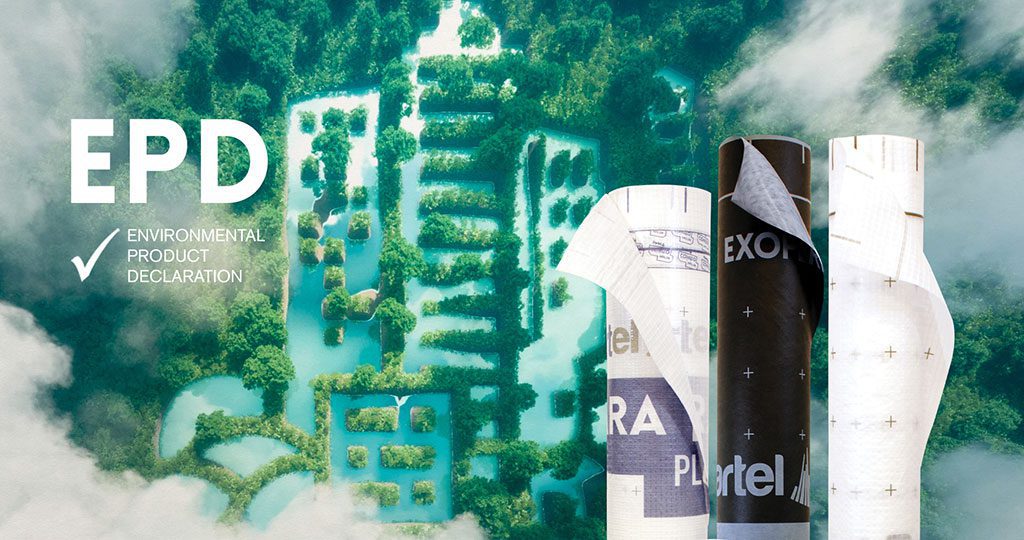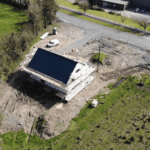Partel has become the first manufacturer of building envelope systems in Ireland to publish Environmental Product Declarations (EPD) for air and windtight membranes. With these third-party reviewed EPDs, it’s now possible to measure our product´s environmental performance and impact on the overall project. This action is part of our commitment to the responsible performance of buildings and sustainable production processes.
The first Partel products to attain the Environmental Product Declaration (EPD) consist of five of the most popular airtight solutions widely specified in low-energy projects: EXOPERM MONO 150, EXOPERM MONO SA 250, and ECHOFOIL EXO breathable membranes, along with VARA PLUS and IZOPERM PLUS vapour control layers.
Partel’s commitment towards carbon-neutral construction
By 2030, all new buildings must be net-zero carbon in operation, and embodied carbon in building materials and equipment must be reduced by at least 40% from today’s levels.
This transition to an efficient and resilient construction sector with zero-carbon emissions across the life cycle of the built environment calls for a sector-wide transformation that applies the principles of a circular economy.
We, in Partel, are playing our part in this movement toward decarbonization and joining the existing companies in the collective effort of supporting effective passive design measures by empowering designers, and builders to make informed decisions about embodied carbon of ingoing building materials.
“Accelerating carbon reduction through sustainable building components and energy usage reductions are default parts of our business practices. This is the key area that can drive a real positive impact, and we know that transparency is important, especially for responsible procurement. The EPDs allow us to demonstrate fully transparent, and reliable data to the construction market on our materials, and carbon footprint.” said Hugh Whiriskey, Founder and Director of Partel.
Where can stakeholders access the Partel EPDs?
Partel’s Environmental Product Declarations for air and windtight membranes are operated in Ireland by the Irish Green Building Council (IGBC) and are registered at www.igbc.ie/epd-search/. In Europe, the digital data included in EPDs will soon be available to use on ECO Portal, and One Click LCA and EC3 (Building LCA tools).
The Life Cycle Assessment (LCA) and EPDs were carried out by Peter Seymour, LCA consultant with EcoReview Ireland, an international environmental consultancy, specialising in the construction, manufacturing and food sectors.
Seymour states that “EPDs in the construction sector are the essential currency for communicating the environmental impacts of a product. The Partel EPDs present the environmental impacts from production, installation on site and the end-of-life scenario for the products. They provide independent verified environmental impact data essential for informed decision-making in the current climate crisis. EPDs are being requested more and more in construction as clients and governments are now rigorously measuring the environmental impacts of their projects”.
“Working on this Life Cycle Assessment and EPD project was greatly assisted by the professionalism and efficiency of Partel’s staff.” concluded Seymour.
What is an EPD?
The Environmental Product Declarations (EPDs) are a standardised way of providing relevant, objective, and independently verified data about the environmental impacts of products through their life cycle.
In Europe, they conform to EN 15804 being verified, registered, and published within EPD programmes, following the requirements of ISO 14025.
Why chose products with EPD?
The EPD has a significant contribution in offering reliable knowledge of the life cycle environmental impact of the construction materials. It is compliant with international standards, it’s credible, comparable and provides a comprehensive tool for quality control. This means that EPD can be integrated into building level assessment and used to compare the construction products in a building context from environmental performance point of view.

Who can benefit from the data provided by EPDs?
Designers and architects, who want to differentiate their services and deliver better design, justifying sustainable design choices with scientific evidence. Because the EPD offers comparison between material options and the environmental profile of a product, while meeting regulation requirements.
Builders and developers who want to develop projects that are net-zero, reducing cost and increasing material efficiency. The EPD will help them compare design alternatives, evaluate circularity of materials and design options.
Manufacturers can measure, benchmark, and ultimately reduce the impact of their products through sustainable solutions.
“The EPDs allows us to identify ways to optimise the manufacturing processes, which is essential moving forward. Technical excellence and a low-carbon future are at the core of Partel’s R&D innovation.” states Hugh Whiriskey.
Energy-efficient buildings require effective action covering the entire building life cycle from design and the selection and manufacturing of materials to construction to operations through renovation and deconstruction.
Partel EPDs enable easy access to the market for selecting and specifying the right air and windtight membranes for achieving environmental performance in buildings, combining technical high-quality properties with sustainability.





